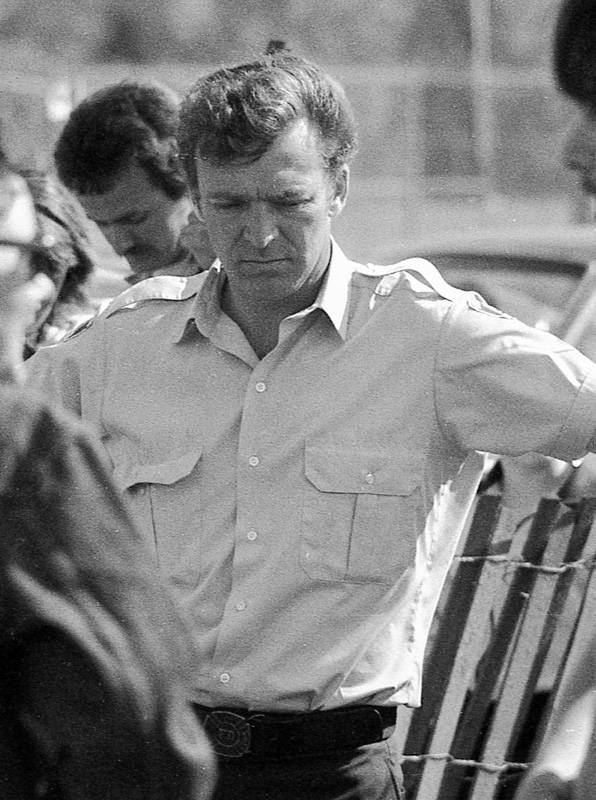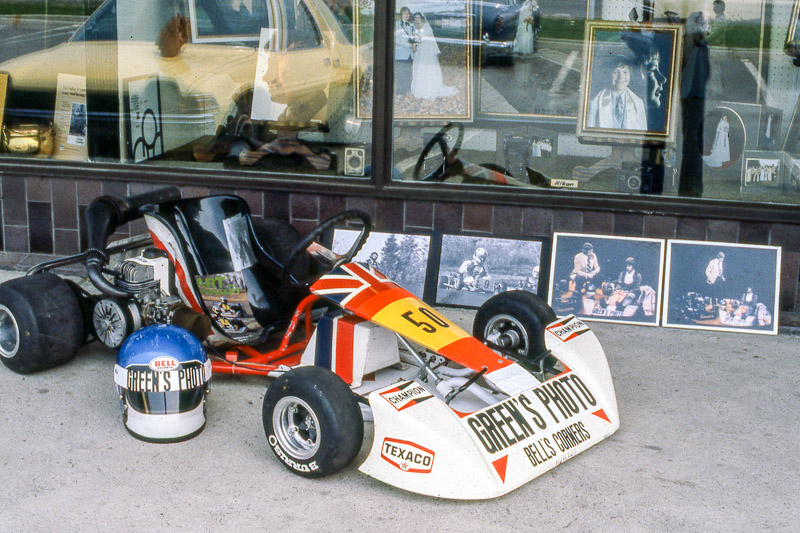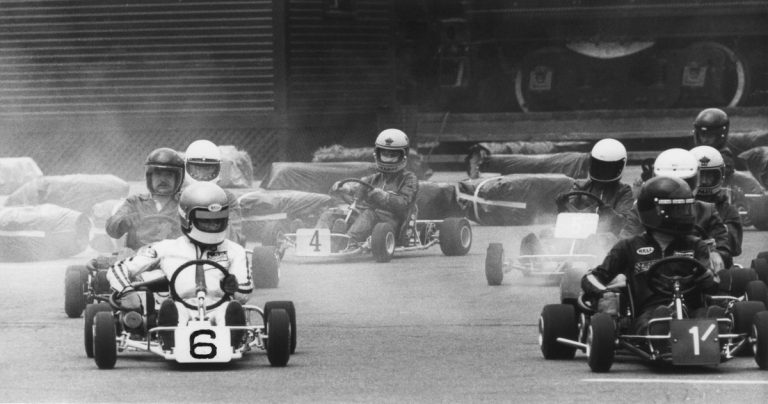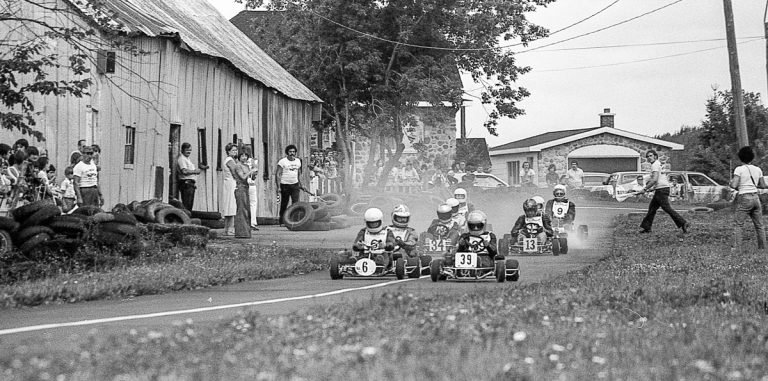Nepean Grand Prix raises $ for kid’s burn unit
Story by Derek Cadzow with contributions from Sean Sweet and Fred Zufelt.
Jan-May, 1980 — By the end of 1979, Ottawa kart racing had been largely dormant since the aborted 1977 championship. Club members had either drifted away or now raced more often out of town. Jon Snadden had retired from racing after a couple of frustrating seasons in the Canadian Pro series, and even my own attention was directed elsewhere since securing a ride in the Pro Series with Montreal’s DAP team (more about that in posts to come).
What was left of the Quyon club held races now and then, but there was no organized program to bring in new karters. Karting in Ottawa was withering on the vine.
If we wanted to continue racing in Ottawa, things would need a major kick in the pants.
Clearly we needed a program around which we could rebuild the club. So, I designed a new championship series for 1980 and took it to the executive of Share 50/74 — the company that owned the Quyon track, now called Le Circuit Quyon.
I was all business. I had a plan with race dates laid out, a proposal for a new rule book and suggestions for the rules, and a budget — yes, an actual budget for a racing series that showed projected revenues from things like entry fees as well as all foreseeable expenses such as race insurance. All the numbers added up and everyone got on board. We started planning for the series in earnest.
One key ingredient in this proposal’s success was the arrival of some new karters from south of the border in New York. Tom Chapman and five or six of his friends had bought Yamaha karts and were looking for a place to race.
It was all fitting together nicely.
Next, we needed a big splashy public event. If we were going to grow the club, people needed to know that karting was back and that these weren’t just rental karts — they were fast and they were exciting. I was sure that we’d get new members if we could just show people what it was really like.
I also wanted to test the waters of sponsorship and be able to offer real exposure to potential sponsors. A big public race would do that.
Any risk was mitigated by our prior experience with public races. We’d had our race at Ottawa’s Museum of Science and Technology a few years earlier and the 1978 Canadian Pro Series finale at Mississauga Square 1 (another future post) had been a huge success. So I knew public races could attract a lot of attention.
But how to get one organized was the question.

In those days I worked for Bell-Northern Research (BNR), a fairly large company with multiple locations in Ottawa, and I often took shuttle rides between the sites. Several of the drivers were off-duty firefighters who drove on their days off and one of them, Ron Ralph, told me how they were trying to think of ways to raise money for the new burn unit at Ottawa’s Children’s Hospital.
It all sounded just too good to be true and the solution to our separate questions seemed pretty obvious to me.
By the time the ride was over, we’d agreed to plan a kart race to attract spectators who could contribute to the firefighters burn unit fund instead of paying for admission. Hopefully, Ron would score for the charity and we’d score interest and maybe some new members for the karting club and have an exciting race to boot!
Ron was the right partner to help pull this off.
He was a firefighter for the city of Nepean, a suburb of Ottawa in Canada. As part of the city’s fire department, he had connections to the city’s politicians and councils and could get the road cleared for us to hold the event. My part was organizing the race and backing Ron up, telling the powers-that-be what we had in mind and what we’d do about safety considerations for the crowd. Honestly, I don’t think they had any idea what kind of karts we were talking about — this was one time that people’s pre-conception of go-karts actually helped us. They gave us their blessing to hold the event.
First, we needed a venue. It had to be in Nepean, of course, and the parking lot had to be big enough to accommodate the track, parking for spectators, standing room for the spectators, and for the fire engines that would be there to promote the charity.
The Nepean Sportsplex, a large sports complex open to all, was the only place big enough to stage the event and the city granted us access for May 25 (a Sunday and a holiday weekend in Canada).

For promotion, the city put up a huge billboard at one of the busiest intersections in Nepean (Baseline & Maitland) showing a line drawing made from my photo of Mike Matthews’ National class kart at the Square 1 event. The 20-foot high words “Nepean Grand Prix” blared down on thousands of passing cars each day. Fred Zufelt, one of our kart-driving colleagues used to drive to the intersection “for no good reason” just to look at the billboard. “It was fantastic”, he said.
Then, the locally-popular CJOH television station and the late sportscaster Brian Smith got involved. Brian had Sean Sweet, a fellow karter, and I bring our karts, helmets, and driving suits to the studio as props for an interview. Brian and I started the interview on stools and then he cut to some film of our karts at speed at the Quyon track. At that point, I was supposed to move from the stool and sit in the kart, where the interview would continue.
(photos: Bill Cadzow)
I was so scared I’d trip or make a noise when the film was running that I didn’t even notice he’d asked me a question. But ever the professional, Brian picked up on my brain fade and kept the conversation going until the cameras came back to us and he asked me a new question. No one watching the show would have been any the wiser. Personally, I had no clue — I think it was Sean who pointed out to me afterwards that’d I’d missed the question. (I used to have a video tape of the show somewhere but it got lost over the mists of time.)
All this helped the newspapers take notice and they ran short stories about the upcoming race. So we certainly had enough publicity for the event — it was more than we’d ever been able to muster before.

To attract even more fans, we also scheduled a “celebrity” race before the main event for local politicians and news people. Paul Joinette, our fellow karting club member, had just opened a new go kart rental business called Karters’ Korners on the west side of the city (karters’ corner lasted until 2020 – a good run). He provided the rental carts for this part of the event. Even if people weren’t that interested in racing, they might come out to see their favorite reporters and politicians slug it out on the track.
The next piece of the puzzle was to design the track we’d need to build on the Sportsplex parking lot.
Our usual track at Quyon was tight and twisty, so I wanted this to be different — fast and open.
I started the design with one long straight that ran the full length of our allotted pavement. Just before it, I put a long sweeping right-hand corner. Drivers would accellerate hard through the corner and would already be flying coming onto the straightaway. After a flat-out run, they’d brake hard for the hard-right hairpin at the end of the straight, which was a great place to pass. All this, of course, was designed for maximum action for the spectators — and on the day, it delivered!
We also needed experienced people to run the race. We enlisted Jon Snadden (retired from kart racing as I mentioned earlier) and Terry Watkiss, a friend of Fred Zufelt’s, as the main race officials. For scoring and timing, we asked Sharon Bertrand, a good friend from BNR, and Elaine Zufelt, wife of driver Fred Zufelt. Finally, we put Ken Mair, one of the co-founders of modern karting in Ottawa, on the microphone as the race announcer — a job that turned out to be harder than any of us thought!
Normally, corner marshaling and flagging was done by our own drivers with mixed results. For this event, we approached the Motorsport Club of Ottawa (MCO) for experienced car race flaggers. They accepted and, as it turned out, their quick thinking during the race prevented a potentially dangerous situation from getting out of control (more on this later) — so it was an extremely fortuitous choice.
With everything all set, the last thing to do was build the track. Since this was a public parking lot, we had to do this on the Saturday night before the race. We measured and laid it out with chalk. Next we installed snow fencing around the perimimeter to protect and hold back the crowds — two layers at the front of the track, and one layer at the back where we could actually sink fenceposts into the ground beside the pavement. It was a heck of a thing to put together, but it was the last line of defence if a kart got out of control — so it had to be pretty solid.
For an inner barrier and cushion for the karts, we had hay bales. The bales and a few plastic pylons marked out the circuit.
A local farmer delivered the bales on Saturday night and we encased them all in transparent plastic bags, provided by Fred Zufelt and his new boss Larry Head at Digital Equipment Corporation (DEC). (Larry was so interested in the event that he volunteered to help officiate on race day.)
This accomplished two things: first, if a kart collided with a hay bale and it split apart, all the loose hay would be contained in the bag and not spill all over the track. Second, it kept the bales intact so we could give them back to the farmer at the end of the day — in essence, we RENTED the bales from the farmer and didn’t end up producing hay garbage!
DEC also helped us out with post-race weighing. You might remember that I had to put lead shot inside my leathers at Picton when we were surprised by their minimum weight rule. Now, we had a weight rule too and this skinny driver had a huge bar of lead bolted to the chassis in order to meet the minimum. That meant we had to weigh each driver and kart at the end of the race. Fred convinced DEC to lend us their departmental shipping scales, to which they very kindly agreed.
As if that wasn’t enough, DEC generously donated a check to the Firefighters for the burn unit. We were very thankful for all their contributions.
It was late when we completed the track. The mosquitos were well-fed that night and we were ready to go home for some well-earned sleep.
All this while, I’d also been squeezing out some time to try and get my own entry ready and prepare my kart for the race.
You’ll recall that part of the reason for a public event was to make sponsorship a commercially viable proposition. While we didn’t have one for the race event itself — there just hadn’t been time for that — I did want to find a sponsor for my kart.
I wasn’t looking for a great deal of money because, after all, it was just for a single race. I wanted to get myself some new tires to replace my four-year-old worn out and definitely un-sticky Goodyears.
Asking people for money is nerve-wracking. The previous year, I’d tried and made it all the way to the company board room of my potential sponsor, but didn’t get any further.
Several weeks before the Nepean race, I made up a flyer about karting, my racing record, what exposure sponsors would get for their money, and then took it with some photographs from shop to shop in Nepean to see who might be interested.
Fortunately it didn’t take too long. I met Bill Green who owned Green’s Photo near the Robertson Road/Moodie Drive intersection. I made my pitch and it was no less intimidating than the first time. He took the flyer and stared at it for a long time — in silence. Bill was a soft-spoken man (I didn’t know that at the time) and I thought he was about to tell me to get lost.
Imagine my shock and surprise when the next words out of his mouth were “Yeah, OK…”
What? Did I just hear that right??
I was elated and got to work plastering his shop name all over my kart and thinking of other ways to support him. I ended up putting it on the new front fairing, on my helmet and on the t-shirts that our team would wear to the event.
The day before the race, I put my kart (and me) on display at the front of the Green’s Photo shop and spent most of the day talking with his customers. Then I headed to the Sportsplex to help put the track together with the rest of the gang. I think that over the 48-hour weekend, I had about six hours total of sleep…

You’ll recall that we had our karts on camera for the CJOH interview too… so Bill’s business name ended up prominently displayed on a city-wide half-hour broadcast. I made sure of that…
It was actually at that same television interview that I realized I wasn’t the only one who had secured a sponsor. When I saw Sean’s kart at the studio, he had a front fairing with the Corkscrew restaurant emblem painted on it.
Sean’s story about searching for a sponsor is eerily similar to mine: he’d prepared a one-page brief and cold-called businesses in Nepean on the same strip that I was working. One of those was the Corkscrew Restaurant.
Sean says he thinks the Corkscrew manager appeared thinking he was going to interview someone for a job. Instead, Sean handed him the brief and gave him the pitch for race sponsorship.
The manager read the brief carefully for a few long and anxious moments (like mine) and said finally: “Sure, that sounds cool…”
Sean was as shocked and surprised as I had been. And even more so as the manager went straight to the cash box and handed Sean the money right there!
“Here you go, good luck”, he said!
Sean walked out the restaurant dumbfounded but having learned the lesson that it doesn’t hurt to ask for what you want…
He enlisted his painter friend, Dez Fitzgerald, to hand paint the Corkscrew Restaurant logo on the front fairing of his Zip kart, which was of course used in the CJOH interview with Brian Smith. So the Corkscrew Restaurant, like Green’s Photo, ended up with coverage in the race AND on a television program broadcast all over Ottawa and Nepean.
How did Sean spend his sponsorship money? Good question — but you’ll have to wait for the second part of this story, about the day of the race, to find out…

My sponsorship money went to that new set of tires…
Burris was the new brand that year and I got my set in plenty of time for the race.
But nothing’s ever that easy. They were wider than the Goodyears and, unfortunately, wider than my rear wheel rims. The rims were made from two halves and a cast centerpiece held together by six bolts. So I got a second centerpiece and cut parts of it away so it would fit snuggly alongside the first one to make the rim wider. New longer bolts held the parts of my creations together.
But it didn’t end there. The rims were also a slightly larger circumference than the tire bead, so even though I greased the rim and inflated the tire to ridiculous pressures, it wouldn’t completely seat properly. In fact, if you look carefully at some of the pictures of my kart in the race, you can see that the edge of the rim extends slightly beyond the tire. It looks a bit like Ben-Hur’s chariot wheels! I was afraid all day that the tires would come off their rim under the cornering load (but they didn’t).
Second, I attached a fiberglass nose fairing. I did this for two reasons, the first of which is obvious: I needed a place to put the sponsor’s name and the fairing made a perfect billboard. I was also looking for whatever aerodynamic advantage I could get, realizing it would be very slight. At the very least it probably helped get the air over the front tires better.
In my typical over-engineering ways, I actually cut the welded chrome bumper off the front of the kart and built a new one that could be bolted back on (like on the Italian karts). This new bumper had integral mounts for the fairing — by the time I’d finished, there was no way the fairing was going to be knocked loose. AND the weight of all this extra construction helped me meet the minimum weight limit too!
As it turned out, I wasn’t the only one making special modifications to the karts for this race, as I was to find out the next day…
Read Part two — 40th anniversary of a thriller race for the kid’s burn unit











